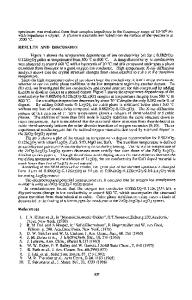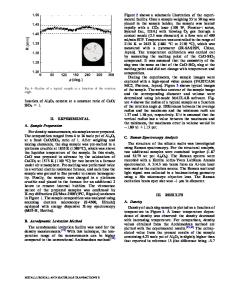Linear Electrogyration Study on Eu:In 2 O 3 Nanocrystals
- PDF / 705,219 Bytes
- 6 Pages / 612 x 792 pts (letter) Page_size
- 41 Downloads / 265 Views
1207-N10-56
Linear Electrogyration Study on Eu:In2O3 Nanocrystals Zhaoyong Sun1, I. V. Kityk2 and Jiye Fang1,* 1 Department of Chemistry, State University of New York at Binghamton, Binghamton, New York, 13902 2 Department of Electrical Engineering, Technical University Czestochowa, Al. Armii Krajowej 17/19, Czestochowa, Poland * [email protected]
ABSTRACT Colloidal Europium-doped In2O3 nanocrystals were successfully prepared in a noncoordinating solvent using indium (III) and europium (III) acetates as precursors. The concentration of doped europium was varied up to 2.88 at%. Linear electrogyration induced by coherent circularly-polarized light was observed from samples in which europium-doped In2O3 nanocrystals were embedded in photopolymer oligoethracryalte matrices. The result on ~2.5 at% europium-doped sample shows that the maximal linear electrogyration could reach to ~12 deg./mm at an electric field of 120V/cm for He-Ne laser.
INTRODUCTION Recently, rare-earth ions doped semiconductor nanocrystals (NCs) have attracted much attention due to their unique optical properties [1-4]. However, most efforts have been concentrated on the luminescence of rare-earth ions doped NCs. There are only a few reports on their linear electrogyration (LEG) properties so far [5]. It was previously believed that LEG effect only exists in single crystals with relatively low values. However, enhanced LEG effect has been observed since 1970s when the exploration systems were extended to ferroelectric materials [6], alumina samples [7], and photorefractive materials [8]. Compared to bulk LEG materials, nanocomposites seem more suitable to be used for LEG study. One of the advantages is that the interfaces which separate the NC and its surrounding matrices could enhance the space dispersion and form additional quantumconfined states. In this case, LEG could be the consequence of a superposition of the quantum-confined electron contribution and the photostimulated, axial-symmetric grating polarization. Simultaneously, the doped rare-earth ions play a role of additional polarization centers which could cause additional polarization-enhanced effects originating from the space dispersion. Moreover, the thickness of the In2O3 NC interface sheet is more homogenous, which determines the high values of the nonlinear optical susceptibilities. All of the mentioned properties above endorse the consideration of europium-doped In2O3 (Eu:In2O3) NCs as a promising material for multi-functional optoelectronic devices operated with circularly polarized light.
In this work, we investigate the circular-light-induced LEG in Eu:In2O3 NCs which were embedded in photopolymer matrices. EXPERIMENTAL DETAILS Sample preparation Eu:In2O3 NCs were synthesized using a modified method described elsewhere[9]. Basically, 0.42 mmol of In(Ac)3 and various amounts of Eu(Ac)3 were mixed with 7.0 ml of hexadecane in the presence of oleic acid (0.60 mL) and oleylamine (0.55 mL) in a three-neck round bottom flask equipped with a condenser. Standard air-free technique
Data Loading...











